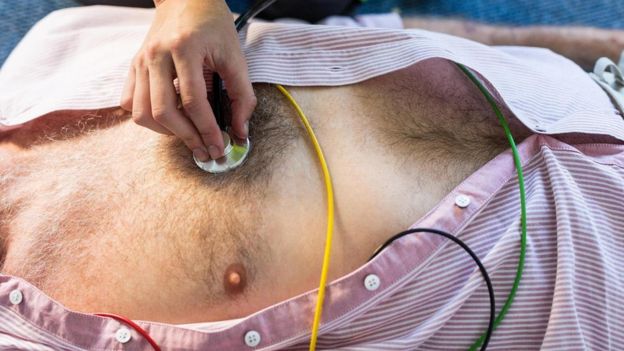你會不會心臟病發作而不自知?
克勞迪亞·哈蒙德(Claudia Hammond)
2017年 9月 29日
 Image copyrightALAMY
Image copyrightALAMY長期以來,人們一直把心肌梗塞比喻成像是有一個重物敲擊你的胸部,同時伴隨著巨大的焦慮感。電影裏,突發心臟病的人會緊緊捂住胸口,眼光中充滿驚恐,然後癱倒在地上。有些心肌梗塞病例的發作表現的確如此,但不是全部。
當心臟供血由於血栓而遭到堵塞時即會出現心肌梗塞。然而在某些情況下,儘管此時體內出現了病症反應,病人卻對此一無所知,從而使他們無法及時得到救治。很多人即便出現中等強度的胸痛,也會認為僅僅是消化不良,但隨後卻在醫院心電圖測試中發現實際上是心肌梗塞在作祟。有人將這種情況稱為"沉默"心肌梗塞。2016年發表的一篇論文指出,這種情況佔心肌梗塞總病例數的45%之多。
人是否會因為傷心而死?
如何確認"有心跳的屍體"已經死亡?
器官移植:你能接受一顆豬心嗎?
這項研究早在1990年代初就開始收集數據。當時的心肌梗塞診斷技術還沒有今天的先進,因此當時可能有誤診情況。但當時仍然存在病人對自己的心肌梗塞毫不知情的現象。
還有病人知道自己身體有病,但不知道是什麼病。他們感覺下顎、頸部、手臂、腹部或背部疼痛,氣短、體虛、眩暈、出汗或嘔吐。他們去醫院檢查診斷的原因是出現了上述症狀的組合,而非感受到嚴重胸痛。
 Image copyrightALAMYImage caption當遭遇心肌梗塞時,男性更容易感受到胸痛(圖片來源: Alamy)
Image copyrightALAMYImage caption當遭遇心肌梗塞時,男性更容易感受到胸痛(圖片來源: Alamy)無胸痛症狀的心肌梗塞更常見於女性,從而延誤了其求救時機,降低了生存機率。為了徹底搞清其中的規律,加拿大研究人員於2009年針對305位接受血管成形術的患者開展了系統性心肌梗塞症狀研究。血管成形術中,需將小氣球植入血管內部,充氣後即可把堵塞的血管重新撐開。手術中,當氣球充氣時即會模仿心肌梗塞發作時的症狀。研究人員在氣球充氣請患者描述自我感受,發現男性和女性患者在胸部不適、手臂疼痛、氣短、出汗或噁心嘔吐等症狀上沒有區別,但是女性患者更容易感受到頸部、下顎和胸部疼痛。
死亡究竟是什麼感覺
死亡真相:人死後身體的變化
如何用"假死"救活垂死的病患?
其他研究的發現則缺乏一致性。有的研究發現男性和女性感到胸痛的概率相同,而有研究則發現男性的概率更高。而有的研究中涉及的病症不只有心肌梗塞,從而使問題更加複雜。於是,研究者於2011年開展了一項專項研究,研究唯一的目標就是調查患有心肌梗塞的男性和女性患者的症狀異同。
專項研究在美國、日本、瑞典、德國、英國和加拿大等國進行,其中研究規模最大的國家調查了90萬多人。對來自質量最高的26項研究的數據進行了匯總和再分析。研究者發現,與男性相比,女性出現胸痛症狀的比例較低,但疲勞、噁心、眩暈、昏迷、頸痛、下顎痛和手臂痛的比例較高。大部分男性和女性都會出現胸痛,但有三分之一的女性和大約四分之一的男性心肌梗塞發作時沒有任何症狀,也根本不知道自己已經發病。
 Image copyrightALAMYImage caption某些心肌梗塞病例不會出現電影裏描述的任何症狀(圖片來源: Alamy)
Image copyrightALAMYImage caption某些心肌梗塞病例不會出現電影裏描述的任何症狀(圖片來源: Alamy)患者沒有症狀就不會立即去尋求幫助。平均而言,患者要等待2-5小時才會去醫院就診。
注意身體信號!它們會改變你的行為
與"猝死"的幽靈終日相伴是何滋味?
人體冷凍術需要考慮哪些後果?
最近開展了一項研究,研究目的是了解人們在感受到多嚴重的症狀時才會去醫院就診。對少量女性心肌梗塞患者所做深入訪談表明,只有一半人感覺不舒服後立即去醫院。某些症狀開始時很輕微,隨著時間的推移不斷惡化,從而迫使她們去醫院就醫。然而,另一半人並不知道這些症狀與心臟相關,也沒有告訴身邊任何人,而是決定等等再看。
每個人都應該知道,劇烈胸痛意味著嚴重健康問題,也是心肌梗塞來襲的前兆。但是其他症狀也會提醒我們心臟出了問題。因此,當出現這些症狀時,我們應當高度提防心肌梗塞的發作,儘管它們和電影裏的情節大相徑庭。
請訪問 BBC Future 閲讀 英文原文。
http://www.bbc.com/future/story/20170912-can-you-have-a-heart-attack-and-not-realise-it
We might think that the effects of a heart attack would be so dramatic they would be impossible to ignore. That’s not always the case.
The classic description of the sensation of a heart attack is that it’s like a heavy weight crushing your chest accompanied by a feeling of overwhelming anxiety. In films people clutch their chests, show panic in their eyes and then fall to the floor. And it can happen just like that. But not always.
Heart attacks occur when the supply of blood to the heart becomes blocked, usually by a blood clot. Despite what’s happening in the body, sometime people feel no chest pain at all, which means they delay getting help. Even with mild chest pain, many assume they have indigestion and only discover later that they’ve had a heart attack after an electrocardiogram in hospital shows damage to the heart. Sometimes this is known as a silent heart attack. A study published in 2016 found this could happen in as many as 45% of heart attacks.
- Is there a link between exercise and depression?
- The incredible things we know about the heart
- The man with two hearts
The data for this research started being collected in the late 1990s and since then the diagnosis of heart attacks has improved, so the figure would probably not be as high today, but every year there are still some people who, at the time, had no idea they were having a heart attack.
There are also patients who knew that they were ill, but not why. They feel pain in the jaw, neck, arms, stomach or back and feel short of breath, weak or light-headed. They might sweat or vomit. It’s the combination of symptoms rather than the severity of chest pain that allows for a diagnosis.
It is often said that these heart attacks without chest pain are more common in women, leading women to delay getting help and reducing their chances of survival. In order to establish whether this really is the case, researchers in Canada in 2009 set out to measure the symptoms of a heart attack systematically, by studying 305 patients undergoing angioplasty. This is where a blocked blood vessel is re-opened by inflating a small balloon inside it. The procedure can briefly mimic the symptoms of a heart attack, so while the balloons were inflated patients were asked to describe what they could feel. They found no differences between men and women in terms of chest discomfort, arm pain, shortness of breath, sweating or nausea, but women were more likely to have pain in the neck and jaw in addition to chest pain.
Women are less likely than men to present with chest pain and more likely than men to have symptoms such as fatigue, nausea, dizziness or fainting
The findings of other studies have been inconsistent, sometimes finding that men and women are equally likely to experience chest pain, others that it’s more common in men. Sometimes the issue is confused by researchers including other diagnoses alongside heart attacks in the same study. So in 2011 a review was conducted, with the sole aim of establishing whether there is a difference in the symptoms experienced by men and women.
Studies from the US, Japan, Sweden and Germany, UK and Canada were all included, the largest involving more than 900,000 people. The data was taken from the best 26 of these studies, combined and re-analysed. They concluded that women are less likely than men to present with chest pain and more likely than men to have symptoms such as fatigue, nausea, dizziness or fainting and pain in their neck, jaw or arms. With both sexes, the majority still experienced chest pain, but a third of women and almost a quarter of men had heart attacks without having any symptoms in their chest, making it hard for them to realise what’s happening to them.
If you don’t know how serious your symptoms are, naturally you’re less likely to go for help. People wait on average between two and five hours.
A new study has sought to find about more about people’s thought processes in making what can be a life-and-death decision to go to a doctor. In-depth interviews with a small number of women who’d had heart attacks revealed that half knew something was wrong and immediately went for help. Three had vague symptoms which began as mild, but then got more intense, prompting them to the doctor. But the remaining people had no idea their symptoms were to do with their heart and didn’t tell anyone else, deciding to wait and see.
So the lesson is that a crushing chest pain is very serious and could indicate a heart attack, but so could a collection of other symptoms, therefore we need to consider the possibility of a heart attack even when it doesn’t seem quite like in the films.
--
Disclaimer
All content within this column is provided for general information only, and should not be treated as a substitute for the medical advice of your own doctor or any other health care professional. The BBC is not responsible or liable for any diagnosis made by a user based on the content of this site. The BBC is not liable for the contents of any external internet sites listed, nor does it endorse any commercial product or service mentioned or advised on any of the sites. Always consult your own GP if you're in any way concerned about your health.
All content within this column is provided for general information only, and should not be treated as a substitute for the medical advice of your own doctor or any other health care professional. The BBC is not responsible or liable for any diagnosis made by a user based on the content of this site. The BBC is not liable for the contents of any external internet sites listed, nor does it endorse any commercial product or service mentioned or advised on any of the sites. Always consult your own GP if you're in any way concerned about your health.
If you liked this story, sign up for the weekly bbc.com features newsletter, called “If You Only Read 6 Things This Week”. A handpicked selection of stories from BBC Future, Earth, Culture, Capital, and Travel, delivered to your inbox every Friday.


沒有留言:
張貼留言